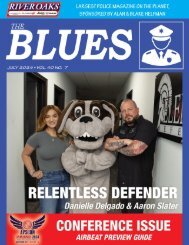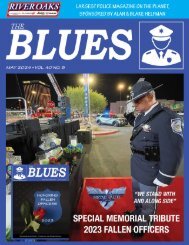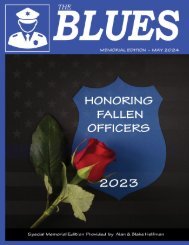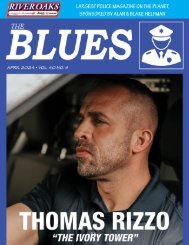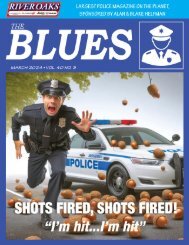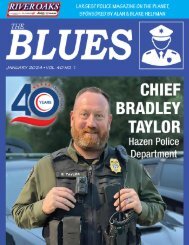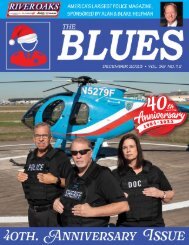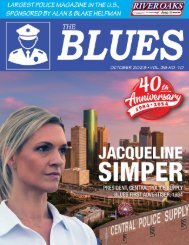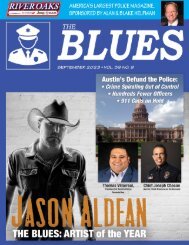MARCH 2022. Blues Vol 38 No. 3
FEATURES 42 Vote Their Ass Out 46 Remembering Those We’ve Lost to COVID 50 Remembering Those We’ve Lost to LOD Deaths 56 10-Year Olds Dream Becomes a Reality DEPARTMENTS 8 Publisher’s Thoughts 12 Editor’s Thoughts 14 Your Thoughts 16 News Around the US 32 Where to Eat - El Mercadito 34 Where to Shop - Central Police Supply 38 Defending Your Rights - James Wood 75 War Stories 84 Aftermath 88 Open Road 92 Healing Our Heroes 94 Daryl’s Deliberations 98 HPOU - From the President, Douglas Griffith 100 Light Bulb Award - Judge Dora & Her Posse 102 Running 4 Heroes 104 Blue Mental Health with Tina Jaeckle 106 Off Duty with Rusty Barron 108 Ads Back in the Day 112 Parting Shots 114 Now Hiring - L.E.O. Positions Open in Texas 138 Back Page
FEATURES
42 Vote Their Ass Out
46 Remembering Those We’ve Lost to COVID
50 Remembering Those We’ve Lost to LOD Deaths
56 10-Year Olds Dream Becomes a Reality
DEPARTMENTS
8 Publisher’s Thoughts
12 Editor’s Thoughts
14 Your Thoughts
16 News Around the US
32 Where to Eat - El Mercadito
34 Where to Shop - Central Police Supply
38 Defending Your Rights - James Wood
75 War Stories
84 Aftermath
88 Open Road
92 Healing Our Heroes
94 Daryl’s Deliberations
98 HPOU - From the President, Douglas Griffith
100 Light Bulb Award - Judge Dora & Her Posse
102 Running 4 Heroes
104 Blue Mental Health with Tina Jaeckle
106 Off Duty with Rusty Barron
108 Ads Back in the Day
112 Parting Shots
114 Now Hiring - L.E.O. Positions Open in Texas
138 Back Page
Create successful ePaper yourself
Turn your PDF publications into a flip-book with our unique Google optimized e-Paper software.
ers and municipal employees the same<br />
percentage raise they gave officers.<br />
Active terms like “collective bargaining,”<br />
“grievance procedure” and even<br />
“due process” wasn’t commonly used.<br />
Feelings intensified among officers that<br />
they had fewer rights of due process<br />
than common crooks. When an officer<br />
was transferred to the jail, Dispatch or<br />
the property room as punishment, he<br />
didn’t speak out for fear his work life<br />
would worsen or he would be labeled<br />
a malcontent for the rest of his career.<br />
“Firings” weren’t labeled as such. The<br />
affected officer literally cleaned out his<br />
locker and was “allowed to resign for<br />
personal reasons.” HPD kept no record<br />
of the number of times this happened.<br />
More aggressive members of the<br />
HPOA board started to keep score and<br />
voiced concern that younger officers<br />
got no legal representation. They preferred<br />
that money be designated for<br />
legal assistance rather than nighttime<br />
softball leagues. The scorekeepers<br />
found that the retention rate of officers<br />
had reached a new low point. New recruits<br />
in town expected a totally different<br />
philosophy than the mild-mannered<br />
HPOA. Some association members had<br />
growing families and felt unions like<br />
those in the <strong>No</strong>rtheast endorsed work<br />
stoppages and strikes. HPOA President<br />
Bill Elkin and the association wanted<br />
nothing to do with an organized union.<br />
Under Elkin’s leadership, HPOA acquired<br />
land two blocks west of headquarters<br />
at 61 Riesner. The president also appointed<br />
the organization’s first African<br />
American board member, J. J. Berry.<br />
A growing number of new HPD officers<br />
hailed from Chicago, New York,<br />
Philadelphia and Boston. Many of these<br />
officers had walked picket lines with<br />
their dads, while Texas-born officers<br />
had lived in a right-to-work state.<br />
About the same time Bob Thomas of<br />
Central Patrol became a more active<br />
HPOA member, so did Tommy Britt<br />
of <strong>No</strong>rth Shepherd, Rick Ashwood of<br />
Central, Raymon McFarland or <strong>No</strong>rth<br />
Shepherd, Doug Carr of Central/<strong>No</strong>rth<br />
Shepherd and Chris Gillespie of <strong>No</strong>rtheast.<br />
Gillespie was from the Midwest<br />
and had a college degree. “It was<br />
almost like the perfect storm of people<br />
coming together,” Britt said. Each had<br />
his own strengths. Gillespie, for example,<br />
introduced the idea of collective<br />
bargaining, grievance procedures and<br />
career development.<br />
OLD INFLUENCE VS. NEW FACTION<br />
Vast differences existed with the<br />
older, more influential HPOA members.<br />
The younger faction had some college<br />
hours. These six activists each worked<br />
in uniform on weekends and nights or<br />
evenings, while the majority of HPOA<br />
board members had 8-to-5 desk jobs,<br />
take-home cars and didn’t have to wear<br />
uniforms. Each of the younger challengers<br />
had a grievance of one kind<br />
or another and sought the strength<br />
in numbers to resolve their problems.<br />
They felt the need to take a more strident<br />
involvement in the organization to<br />
deal with their perception that some of<br />
the people running the department had<br />
a moral compass that wasn’t running<br />
true north.<br />
As early as 1978, Britt, Bob Thomas<br />
and four others ran as “a reform slate”<br />
for the HPOA board. Thomas and Ashwood<br />
were already board members but<br />
unsuccessfully sought board leadership<br />
offices, causing them to believe they<br />
needed a new union.<br />
Thomas soon got the reputation as a<br />
troublemaker. Older members weren’t<br />
reluctant to express their desire to give<br />
him a good old-fashioned “whupping.”<br />
The bitterness from his 1975 near-death<br />
line-of-duty experience remained a<br />
chip on his shoulder and he sometimes<br />
came across as a smart aleck. Yet his<br />
leadership was effective enough for<br />
Britt and many others to later conclude<br />
that most of the good things that happened<br />
to officers took place because of<br />
Thomas’ leadership.<br />
These new activists were soon known<br />
by a new universal identifier, “Baby<br />
Boomers,” the first generation to grow<br />
up in the sixties, affected by protests<br />
for civil rights and women’s liberation<br />
or against the Vietnam War. The<br />
officers figured they could conduct their<br />
own form of protest and maybe get<br />
somewhere. Yet the priority for HPOA<br />
President A. J. Burke, a popular solo<br />
motorcycle officer, was a new location<br />
for the association’s headquarters. Real<br />
estate sources offered two intriguing<br />
possibilities. One was the Brazos Hotel<br />
in downtown, the other the Atascocita<br />
Country Club property on the northeast<br />
side.<br />
Both had high asking prices, discouraging<br />
most HPOA members. The association<br />
could have used the golf course<br />
for its golf-playing members and sold<br />
off most of the remaining acreage to a<br />
developer. Instead, the board decided<br />
to lease a building on Jackson Street in<br />
downtown that once housed the Salvation<br />
Army and was later torn down<br />
to make way for the George R. Brown<br />
Convention Center.<br />
HPOA then purchased property at<br />
1600 State Street, two blocks from 61<br />
Riesner, where it constructed a building<br />
opened in 1983 later dedicated to the<br />
late Lieutenant Breck Porter, a hero in<br />
the establishment of state civil service<br />
protection for officers. To help pay for<br />
the facility, HPOA sponsored a country<br />
and western concert with Roy Clark as<br />
one of the headliners in the old Coliseum.<br />
Outside supporters bought steers<br />
at the Houston Livestock Show & Rodeo<br />
and donated the proceeds to HPOA, the<br />
beef used at benefit barbecues.<br />
<strong>No</strong>t until grand juries stepped up<br />
investigations of police brutality cases<br />
did HPOA hire a lawyer to represent<br />
members who were targets in these<br />
investigative procedures. The first was<br />
one was a former HPD officer, John<br />
Lohmann, through his firm Lohmann,<br />
Glazer and Irwin. Another legal counselor,<br />
D. Reid Walker, also was hired<br />
through Lohmann’s firm and became an<br />
authority in state civil service law.<br />
Thomas and a growing list of ardent<br />
followers of uniformed patrol officers<br />
on duty after dark readily asserted that<br />
pay raises were one thing but legal<br />
representation and insurance benefits<br />
were quite another. At the birth of the<br />
Houston Police Patrolmen’s Union on<br />
October 29, 1979, founding President<br />
Thomas stressed points like these and<br />
backed up his words at frequent news<br />
conferences. The new union concerned<br />
Mayor McConn, Police Chief Caldwell<br />
and long-time political movers and<br />
shakers more than a Category Five<br />
hurricane. Thomas thought he would<br />
be fired and postponed the first secret<br />
organizational meeting for the union<br />
until his wife Pam gave birth to their<br />
youngest daughter in September. He<br />
didn’t want to lose maternity benefits.<br />
Summoned to Caldwell’s office on<br />
the day he announced formation of the<br />
new union, Thomas became physically<br />
ill, thinking he would be dismissed<br />
along with other union founders. From<br />
outside Caldwell’s office, he heard the<br />
chief rant and rave about the union and<br />
the disloyal officers who formed it. As<br />
the minutes ticked into hours, Thomas<br />
remained apprehensive, but his confidence<br />
slowly grew. He later learned<br />
that influential Houston area AFL-CIO<br />
labor leader Don Horn wised up Mc-<br />
Conn. The mayor was about to win his<br />
second term with Horn’s political influence<br />
and listened on the phone as Horn<br />
posed important questions: What had<br />
Thomas done that any other officer was<br />
entitled to do under the Constitution?<br />
What law had he broken? Was the city<br />
ready to combat the lawsuit that would<br />
result from a firing?<br />
According to McConn, he told Chief<br />
Caldwell to use every resource to<br />
discredit Thomas, thinking it was just<br />
a matter of time before they broke up<br />
HPPU. But HPPU membership grew by<br />
leaps and bounds because Thomas and<br />
union leaders were hitting HPOA in its<br />
weakest spots – its inability to publicly<br />
articulate the issues impacting working<br />
officers.<br />
LE AGENCIES<br />
Having staff attorneys to provide<br />
legal advice to members was in high<br />
demand by officers anxious about<br />
situations like the infamous Joyvies and<br />
Webster incidents. The union felt that<br />
having a lawyer at either of these cases<br />
might well have completely changed<br />
the dynamics of the resulting investigations.<br />
As it was, people were fired and<br />
lives destroyed at the feet of the HPOA,<br />
whose dues were $3.50 a month, which<br />
HPPU contended were not enough to<br />
hire lawyers.<br />
Thomas argued that a lawyer at the<br />
scene in which officers said suspect<br />
Randy Webster was armed with a<br />
pistol would have made a dramatic difference.<br />
Had a union lawyer been there<br />
to sort out the facts, the investigation<br />
would have shown the case to believe<br />
what many HPD officers believed it really<br />
was – an accidental shooting at the<br />
hands of one officer. The findings could<br />
well have been that his gun safety was<br />
horrendous, but it wasn’t an indictable<br />
offense. The union leaders suggested<br />
that when you have a lawyer come up<br />
and say, “What happened?” ninety-nine<br />
CALL FOR<br />
PRICING<br />
Supplying Law Enforcement<br />
Equipment for the State of TEXAS!<br />
FN509<br />
MRD-LE<br />
DR920<br />
COMBAT<br />
PROMOTION ENDS 3/31/22<br />
66-101287<br />
OPTIC READY WITH<br />
SUPPRESSOR<br />
HEIGHT SIGHTS<br />
LAPD<br />
VERSION 9MM<br />
CALIBER: 9MM<br />
CAPACITY: 17+1<br />
SIGHTS: NIGHT SIGHTS<br />
BARREL LENGTH: 4.0”<br />
SS-2006<br />
OPTIC READY<br />
9MM<br />
CALIBER: 9MM<br />
CAPACITY: 17+1<br />
SIGHTS: NIGHT SIGHTS<br />
BARREL LENGTH: 4.5”<br />
590<br />
SECURITY<br />
TACTICAL<br />
12661<br />
OPTIC READY<br />
12GA50778<br />
M2.0<br />
M&P<br />
M2.0<br />
CALIBER: 12GA<br />
CAPACITY: 6+1<br />
SIGHTS: BEAD<br />
BARREL LENGTH: 18.5”<br />
STOCK: SYNTHETIC<br />
CALIBER: 9MM<br />
CAPACITY: 17+1<br />
SIGHTS: NIGHT SIGHTS<br />
BARREL LENGTH: 5.0”<br />
CALL OR EMAIL US FOR PRICING OR ASK US ABOUT DEMOS OR TRADE-INS<br />
Tel: 800-367-5855<br />
www.proforceonline.com<br />
WRMCX-11B-TAP-SBR<br />
AGENCY ONLY<br />
MCX<br />
SBR<br />
SAINT<br />
VICTOR<br />
AR15<br />
percent of the time officers are going to<br />
do the right thing.<br />
HPPU pioneers also believed the most<br />
controversial case in HPD history – the<br />
death of Joe Campos Torres – may not<br />
have happened had there been a strong<br />
police union in place pressing issues<br />
such as the faulty, under-budgeted jail<br />
conditions at the time of the events of<br />
May 5-7, 1977. HPD had a clinic in the<br />
basement of the jail since the building<br />
opened in the 1950s but never manned<br />
it. Officers with an injured suspect<br />
routinely went to Ben Taub General<br />
Hospital.<br />
About the Author: Tom Kennedy is the<br />
President of Kennedy Communicatios.<br />
Kennedy states he “Writes and consult<br />
for the good guys.” Kennedy has<br />
been the editor of the Badge & Gun,<br />
the monthly magazine of the Houston<br />
Police Officers Union, since 2002. The<br />
B&G comes out every month. Kennedy<br />
has written five books, including Houston<br />
Blue (co-author with Mitchel Roth), the<br />
history of the Houston Police Department.<br />
CALIBER: 5.56 NATO<br />
CAPACITY: 30+1<br />
SIGHTS: FLIP UP<br />
BARREL LENGTH: 11.5”<br />
STOCK: TELE-FOLD<br />
5.56 STV916556B<br />
CALIBER: 5.56 NATO<br />
CAPACITY: 30+1<br />
SIGHTS: FLIP UP<br />
BARREL LENGTH: 16.1”<br />
STOCK: ADJUSTABLE<br />
Support Center: 2625 Stearman Road, Prescott AZ, 86301 Tel: (800) 367-5855<br />
e-mail: sales@proforceonline.com | www.proforceonline.com<br />
Gear & accessories for law<br />
enforcement AGENCIES<br />
CHECK OUT THESE GREAT<br />
MANUFACTURERS<br />
AIMPOINT • BERETTA • COLT<br />
BIANCHI • TASER • BENELLI<br />
SMITH & WESSON • CZ USA<br />
H&K • DANIEL DEFENSE • EOTECH<br />
SIG SAUER • SHADOW SYSTEMS<br />
DEFENSE TECHNOLOGY • AGUILA<br />
SPETZ GEAR • BURRIS • UTM<br />
MOSSBERG • PROTECH • RUGER<br />
STREAMLIGHT • MAGPUL<br />
SAFARILAND • SPRINGFIELD<br />
BLACKHAWK • OSS • HOLOSUN<br />
TRIJICON • SUREFIRE • BOLA WRAP<br />
US PEACEKEEPER • OTIS<br />
NIGHTSTICK • FNH USA<br />
NOTE: TERRITORY RESTRICTIONS MAY APPLY<br />
Visit our website today for up to date<br />
information, pricing and products!<br />
82 The BLUES POLICE MAGAZINE The BLUES POLICE MAGAZINE 83






